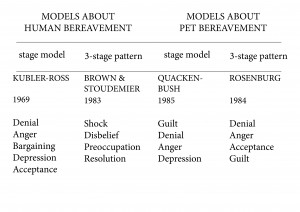“IS THE GRIEF SIGNIFICANTLY DIFFERENT WHEN MOURNING PETS?”
There isn’t a definite answer, nonetheless, the theoretical models of human bereavement can serve as guidelines to understanding the normal response to loss.
“Bereavement: A loss due tot the death of someone to whom one feels close, and the process of adjustment to that loss. Additionally, behaviour of the bereaved and the community after a death, including culturally accepted customs and ritual is referred to as mourning (Papalia & Wendkos-Olds, 1998).”
Sometimes, pet owners are faced with a difficult question: whether to euthanise a pet. Euthanasia is in fact a decision that lies within the owner, of terminating the life of the animal. This decision further complicates the grief and guilt on pet owners. Mckhann (1999) stated “man is the only animal that can contemplate its own mortality” (p.134). Thus this affects the social consequences that inevitably follows when the decision of euthanising a pet has been made.
The process and decision of euthanasia is common for pet owners, but with little public awareness among pet owners. Which result in pet owners doubting themselves with regards to grieving over their pets and also to get through this guilt that leaves within them.
“This also tells us that society fails to identify and understand the magnitude of animal euthanasia and how it impacts the pet owner and the bereavement process. (pg. 5)”
Therapist will be confronted with a patient who makes decision about euthanising their pet. As a therapist, it is imperative that one’s bias does not enter into the client’s decision-making process. According to Ross-Barton and Baron-Soren:
“Client seek your help because they are confused and upset. They may be unable to think clearly and rationally. They may require a great deal of support in working through their issues in order to achieve an acceptable solution.”
Through the above table, guilt is a common emotion that follows the death of a pet. An apparent reason is to euthanise a pet. Additionally, when a pet owners cannot afford to save the pet’s life.
On the other hand, Freud’s main proposition mourning is that it is an expression of pathological mourning. Which is believed that the loss of a significant other is a conscious concern of the mourners who are aware of their own feelings, of what the lost person means to them and how the loss may change their lives.
Nieburg and Fischer (1982) identified that pet attachement at different stages will result in different grief reactions. Example, couples who do not have kids and have pets instead, regards their pets as kids. This in turn would result the couple to experience the same type of painful separation and grief responses that a parent goes through when they lose a child. This applies to individuals as well, as they are dependent on pets to give them a sense of companionship. Lastly, older pet owners gets easily attached to pets as it is like their last purpose in life to care for someone else. They can active with them and becomes productive. Thus with different attachment comes along with the grief that could be similar to that when a human loses someone close to them.
